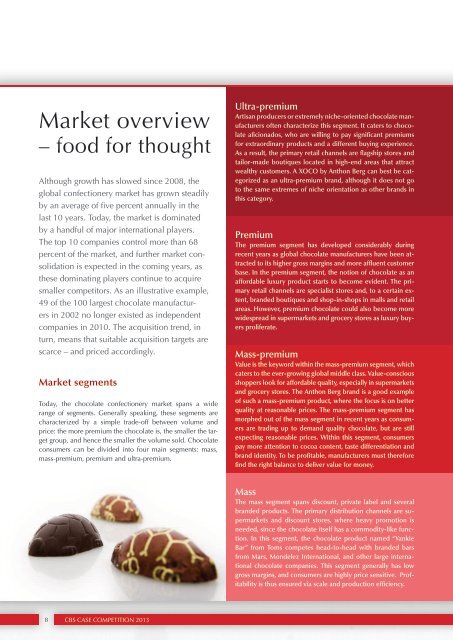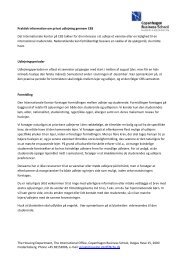Untitled - CBS Observer
Untitled - CBS Observer
Untitled - CBS Observer
You also want an ePaper? Increase the reach of your titles
YUMPU automatically turns print PDFs into web optimized ePapers that Google loves.
Market overview<br />
– food for thought<br />
Although growth has slowed since 2008, the<br />
global confectionery market has grown steadily<br />
by an average of five percent annually in the<br />
last 10 years. Today, the market is dominated<br />
by a handful of major international players.<br />
The top 10 companies control more than 68<br />
percent of the market, and further market con-<br />
solidation is expected in the coming years, as<br />
these dominating players continue to acquire<br />
smaller competitors. As an illustrative example,<br />
49 of the 100 largest chocolate manufactur-<br />
ers in 2002 no longer existed as independent<br />
companies in 2010. The acquisition trend, in<br />
turn, means that suitable acquisition targets are<br />
scarce – and priced accordingly.<br />
Market segments<br />
Today, the chocolate confectionery market spans a wide<br />
range of segments. Generally speaking, these segments are<br />
characterized by a simple trade-off between volume and<br />
price: the more premium the chocolate is, the smaller the target<br />
group, and hence the smaller the volume sold. Chocolate<br />
consumers can be divided into four main segments: mass,<br />
mass-premium, premium and ultra-premium.<br />
8<br />
<strong>CBS</strong> CASE COMPETITION 2013<br />
Ultra-premium<br />
Artisan producers or extremely niche-oriented chocolate manufacturers<br />
often characterize this segment. It caters to chocolate<br />
aficionados, who are willing to pay significant premiums<br />
for extraordinary products and a different buying experience.<br />
As a result, the primary retail channels are flagship stores and<br />
tailor-made boutiques located in high-end areas that attract<br />
wealthy customers. A XOCO by Anthon Berg can best be categorized<br />
as an ultra-premium brand, although it does not go<br />
to the same extremes of niche orientation as other brands in<br />
this category.<br />
Premium<br />
The premium segment has developed considerably during<br />
recent years as global chocolate manufacturers have been attracted<br />
to its higher gross margins and more affluent customer<br />
base. In the premium segment, the notion of chocolate as an<br />
affordable luxury product starts to become evident. The primary<br />
retail channels are specialist stores and, to a certain extent,<br />
branded boutiques and shop-in-shops in malls and retail<br />
areas. However, premium chocolate could also become more<br />
widespread in supermarkets and grocery stores as luxury buyers<br />
proliferate.<br />
Mass-premium<br />
Value is the keyword within the mass-premium segment, which<br />
caters to the ever-growing global middle class. Value-conscious<br />
shoppers look for affordable quality, especially in supermarkets<br />
and grocery stores. The Anthon Berg brand is a good example<br />
of such a mass-premium product, where the focus is on better<br />
quality at reasonable prices. The mass-premium segment has<br />
morphed out of the mass segment in recent years as consumers<br />
are trading up to demand quality chocolate, but are still<br />
expecting reasonable prices. Within this segment, consumers<br />
pay more attention to cocoa content, taste differentiation and<br />
brand identity. To be profitable, manufacturers must therefore<br />
find the right balance to deliver value for money.<br />
Mass<br />
The mass segment spans discount, private label and several<br />
branded products. The primary distribution channels are supermarkets<br />
and discount stores, where heavy promotion is<br />
needed, since the chocolate itself has a commodity-like function.<br />
In this segment, the chocolate product named “Yankie<br />
Bar” from Toms competes head-to-head with branded bars<br />
from Mars, Mondelez International, and other large international<br />
chocolate companies. This segment generally has low<br />
gross margins, and consumers are highly price sensitive. Profitability<br />
is thus ensured via scale and production efficiency.<br />
9
















